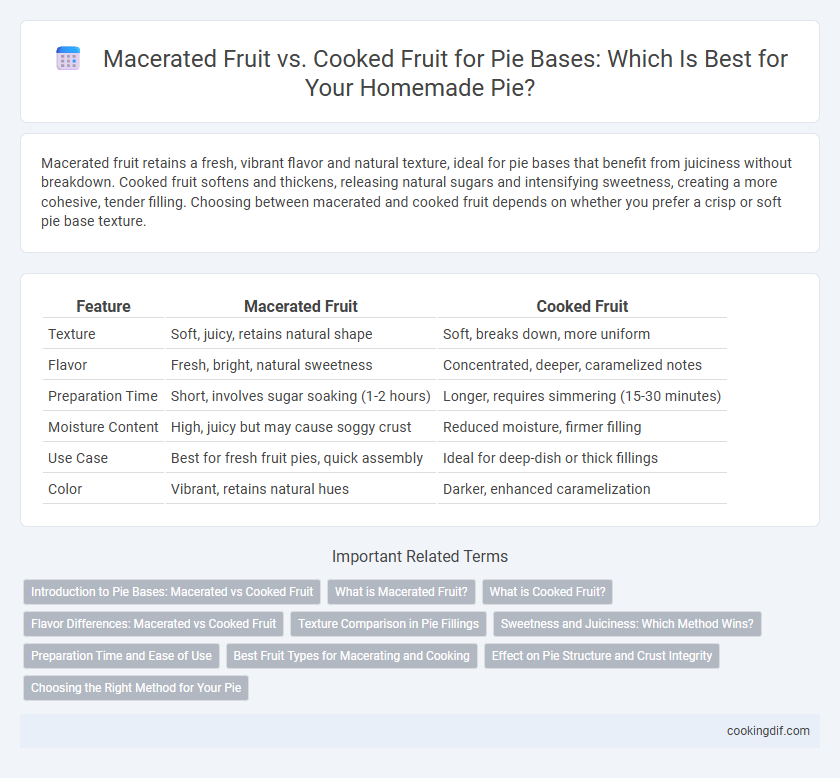Macerated fruit retains a fresh, vibrant flavor and natural texture, ideal for pie bases that benefit from juiciness without breakdown. Cooked fruit softens and thickens, releasing natural sugars and intensifying sweetness, creating a more cohesive, tender filling. Choosing between macerated and cooked fruit depends on whether you prefer a crisp or soft pie base texture.
Table of Comparison
| Feature | Macerated Fruit | Cooked Fruit |
|---|---|---|
| Texture | Soft, juicy, retains natural shape | Soft, breaks down, more uniform |
| Flavor | Fresh, bright, natural sweetness | Concentrated, deeper, caramelized notes |
| Preparation Time | Short, involves sugar soaking (1-2 hours) | Longer, requires simmering (15-30 minutes) |
| Moisture Content | High, juicy but may cause soggy crust | Reduced moisture, firmer filling |
| Use Case | Best for fresh fruit pies, quick assembly | Ideal for deep-dish or thick fillings |
| Color | Vibrant, retains natural hues | Darker, enhanced caramelization |
Introduction to Pie Bases: Macerated vs Cooked Fruit
Macerated fruit in pie bases retains a fresh, vibrant flavor and natural juiciness by soaking fruit in sugar or alcohol, enhancing sweetness and texture without heat. Cooked fruit offers a softer, more uniform consistency by breaking down cell walls through heat, which intensifies flavor and thickens juices for a stable filling. Choosing between macerated and cooked fruit depends on the desired texture and flavor profile of the pie, with macerated fruit providing a lively bite and cooked fruit delivering a smooth, cohesive base.
What is Macerated Fruit?
Macerated fruit refers to fresh fruit that has been soaked in sugar or a liquid such as alcohol or citrus juice, allowing it to release its natural juices and soften without cooking. This process enhances the fruit's flavor and creates a syrupy consistency ideal for pie bases, providing a fresh and vibrant taste compared to cooked fruit. Using macerated fruit in pie bases preserves the fruit's texture and brightness, resulting in a more delicate and flavorful filling.
What is Cooked Fruit?
Cooked fruit in pie bases refers to fruit that has been gently heated or simmered before being added to the crust, which helps to break down the fruit's structure, releasing natural juices and softening its texture. This process often enhances flavor concentration and ensures a more even consistency in the pie filling by preventing undercooked fruit after baking. Compared to macerated fruit, cooked fruit offers a smoother, more cohesive filling ideal for pies such as apple or cherry where a tender texture is desired.
Flavor Differences: Macerated vs Cooked Fruit
Macerated fruit for pie bases retains a fresh, vibrant flavor with enhanced natural sweetness and juiciness due to the soaking in sugar or liquor, allowing the fruit's original taste to shine through. Cooked fruit develops a deeper, more concentrated flavor profile as heat breaks down cell walls, intensifying sweetness and creating a softer texture that blends more harmoniously with pie crusts. Choosing macerated fruit emphasizes brightness and freshness, while cooked fruit delivers richer, more complex taste notes essential for traditional pie fillings.
Texture Comparison in Pie Fillings
Macerated fruit retains a firmer, juicier texture in pie fillings compared to cooked fruit, which tends to be softer and more tender due to heat breakdown of cell walls. The maceration process allows fruit to release natural juices while maintaining structural integrity, enhancing the contrast between filling and crust. Cooked fruit base often yields a smoother, more homogeneous texture but may risk becoming mushy if overcooked.
Sweetness and Juiciness: Which Method Wins?
Macerated fruit retains a natural sweetness and releases juices slowly, enhancing pie bases with vibrant, fresh flavors and a pleasant, syrupy texture. Cooked fruit often deepens sweetness through caramelization but can result in a thicker, less juicy filling that sometimes lacks brightness. For optimal juiciness and balanced sweetness, maceration is favored in pie bases, especially for berries and stone fruits.
Preparation Time and Ease of Use
Macerated fruit requires minimal preparation time, as the fruit is simply mixed with sugar and allowed to soften and release juices naturally, making it ideal for quick pie bases. Cooked fruit involves longer preparation, needing simmering to break down the fruit and thicken the filling, which can enhance flavor but adds complexity. For ease of use, macerated fruit offers a straightforward process with less equipment and active cooking, while cooked fruit demands more attention and stove time for consistent results.
Best Fruit Types for Macerating and Cooking
Berries such as strawberries, blueberries, and raspberries are ideal for macerating due to their high water content and delicate texture, which softens and enhances natural sweetness without losing shape. Apples, pears, and stone fruits like peaches and plums are better suited for cooking, as the heat breaks down their firm structure, creating a tender, flavorful base that thickens the pie filling. Combining macerated berries with cooked apples or stone fruits can balance texture and flavor, yielding a superior pie experience.
Effect on Pie Structure and Crust Integrity
Macerated fruit releases juices gradually, preserving the pie crust's crispness and preventing sogginess by minimizing excessive moisture absorption. Cooked fruit tends to be softer and wetter, which can lead to a weaker pie structure and a soggy or broken crust during baking. Using macerated fruit enhances the overall stability of the pie base by maintaining optimal moisture levels and crust integrity.
Choosing the Right Method for Your Pie
Macerated fruit retains its natural texture and intensifies flavor through a sugar-driven process that releases juices, perfect for fresh and tender pie bases. Cooked fruit softens the fruit more thoroughly, creating a thicker, smoother filling ideal for traditional, structured pies that hold their shape during baking. Selecting the appropriate method depends on the desired texture and moisture level, with maceration offering freshness and cooked fruit providing stability.
Macerated fruit vs cooked fruit for pie bases Infographic

 cookingdif.com
cookingdif.com